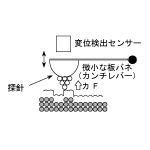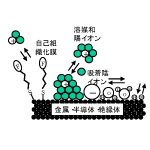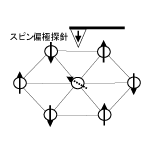|
Research
Study on Manipulating and Assembling of Atom/Molecule
Miniaturization of electric devices using top-down approach will reach the critical limit in near furture.
To overcome the limitation, there are large expectations for bottom-up type nanotechnology, which assembles nanostructure by manipulating atoms/molecules as building blocks.
We have been developing the ultimate technique to manipulate desired atoms or molecules, based on nano-probe technology as represented by a noncontact atomic force microscopy.
This technique allows us to create novel functional materials and to control their physical properties at atomic scale.
 |
Development and Application of Measuring Technique of Elementary Charge at Atomic Level
Surface structures and their charge information are quite important in the process of self-assembly of crystal growth or molecular assembly, or in the quantum phenomenon at microscopic electronic devices.
We will develop an electrostatic force microscope that makes possible to stably-observable material's surface electric charge at the atomic level, and study to clearly establish a link between atomic array structures (for example, array structure of organic material, semiconducting material, or biomaterial) and charged state at the atomic level, from the point of view of fundamental solid-state science.
 |
Study on Solid-Liquid Interface at Atomic Level
Solid-liquid interface relates to quite wide and great variety of technological/study fields.
For example, in the biotechnological field, it encompasses a biological film, or revealing the DNA structure and function.
Also, solid-liquid interface relates to a highly-functional environmental catalyst, a new environmental sensor, etc., in the environment-related field.
To understand the principle of a reaction on the solid-liquid interface and control the reaction, it is absolutely imperative to have knowledge about solid-liquid interface at the atomic/molecule level.
However, a directly observable method in liquid has not been fully established yet.
We will develop the method to make it possible to observe the solid-liquid interface at the atomic level directly, and will study static/dynamic behavior of a self-assembled film, biological molecules, and variety of absorbed ions.
 |
Study of Surface Magnetism at the Atomic Level
Some interesting magnetic properties express on a surface, like colossal magnetoresistance, Curie temperature which is different from bulk, or antiferromagnetic coupling.
In addition, there has been more interest in surface spin rapidly, combined with expectation for the future search of functional materials, like ultrahigh-density magnetic memory, spin device, or quantum spin arithmetic element.
We will develop a method that allows surface spin to be directly observed at the atomic level, and will study magnetic property of new material phase that express on the surface/interface of materials, from the point of view of fundamental solid-state science.
|
